310 years ago Peter I laid the Peter and Paul Fortress
The question of the need to create a defensive fortification, the main task of which was to protect the Russian lands from the encroachments of the Swedes, was long overdue. The constant rivalry between the two powers for access to the Baltic, accompanied by military actions of the 1700-1721 (the Northern War), required urgent measures, because the old fortress of Nienschanz (Shlotburg) could no longer provide reliable protection. For the construction of a new defensive structure, an island was chosen that was seven hundred and fifty meters long and about four hundred meters wide, which the Finns called Zayachy (Enisaari), and the Swedes - Merry (Lust Eyland). From this territory, all approaches from the Gulf of Finland to the Neva were best viewed.
It was the Peter and Paul Fortress that became the starting point for the construction of the first Russian port on the Baltic coast. On the day of the Holy Trinity, in 1703, the construction of the initial woody-earth defensive construction began, the plans for which were built personally by Peter I. He entrusted the work to his first assistant A. Menshikov. The fortress was created in accordance with the rules of the Western European bastion system adopted at that time: the outlines of the structure repeated the shape of the island on which the construction was carried out, and well-fortified protruding bastions were located at the edges of the elongated hexagon. Engineering leadership of the construction of the fortress in the 1703-1705-th years and subsequent modifications carried out military engineer Kirstein from Saxony.
All six bastions were named by Peter in honor of their Companions, who not only supervised the construction, but also participated in its financial support: Menshikov, Trubetskoy, Naryshkin, Golovkin and Zotov. Also one of the bastions was called Gosudarev, in honor of Peter the Great himself. The fortress was originally called St. Petersburg, but already then some residents called it Peter and Paul, named after the new apostle Peter and Paul in the territory of the new citadel of the cathedral. This name became official only in 1917. The status of the cathedral, rebuilt later and also renamed Petropavlovsk, received only in 1731. Contemporaries, he is also known as the tomb of all the emperors of the house of Romanov. It is precisely in its walls that the remains of Russian sovereigns are kept, starting from Peter the Great and ending with Nicholas II. When at the beginning of the 20th century there was a shortage of places for the burial of members of the Romanov dynasty, it was decided to build the church of the holy Prince Alexander Nevsky next to the church, which became the grand duke’s tomb.
Between themselves, the bastions of the fortress were connected by high curtain walls or walls, called Petrovskaya, Vasilyevskaya, Neva, Kronverkskaya, Ekaterininskaya and Nikolskaya. In addition, for attacks in the camp of the enemy, if he manages to stay at the walls of the fortress, saps and sorts (underground passages) with passages (patterns) in the walls were equipped and carefully masked. In each of the walls, except for Ekaterininskaya, there were gates of the same name, but the main ones were always considered the Petrovskie gates, intended for entry into the city. Inside the Catherine's curtain barracks were made, as well as special casemates, which kept weapon. Interesting is the story of Nikolskaya Kurtina, which got its name due to the fact that it was addressed to the church of St. Nicholas. In the 18th century, an expedition to separate gold from silver was housed here, as well as employees of the commandant’s department. Today, the left side of Nikolskaya curtain belongs to the Mint.
In 1704-1705's, triangular ravelins were rebuilt from the land for additional fortification from the sea. One of them, Peter, named Alexeyevsky in honor of his father, and the second, in honor of his brother, Ioannovsky. Then, in 1705-1709-s, the fortress was strengthened from the land, having built a kronverk - an earthen wall shaped like a crown. Also in 1705, a pentagonal earthen cavalier was built to enable the enemy to fire top. Looking ahead, it is worth noting that all the earthen ramparts were demolished in 1850, and a building was built on the site of the crownwork, in which all Russian military relics were stored and stored: banners, awards and various types of weapons.
According to historical data, the French specialist Lambert, a specialist in the construction of forts hired by him, was engaged in mathematical calculations in the construction of the emperor’s drawings. By the forces of the soldiers, the captured Swedes, and also the peasants sent to build each province by October 1703, the construction of the earthwork was completed, but the flood that occurred soon showed the fragility of the structure, part of which was simply washed away with water. That is why there was an urgent need to dress a fortress in stone. This work was begun in 1706 by architect Trezzini and engineer-general Lambert de Guerin, replacing the chief engineer of the project Kirstein who left Russia. From 1727 and up to the end of the main alterations in 1740, all the perestroika work in the fortress was led by military engineer Christopher Minich. Officially, the construction of the Peter and Paul Fortress was completed in the 1740 year.
In the 1707 year, the main gates of Peter the Great underwent a thorough restructuring, the wooden gates were replaced by a stone arch with a wooden top floor, on which a statue of the Apostle Peter was installed. Then, in the 1717 year, all wooden elements were finally replaced with stone ones, and on the front of the plot appeared a bas-relief and a lead two-headed eagle. From 1731 to 1740, significant changes took place in the appearance of the Peter and Paul Fortress. First ravelins were erected of stone, then dams (Botardo) were built, fencing off the moats, which isolated the raelins from the main part of the island. Also in the stone was rebuilt and cavalier, named after Empress Anna. The following significant transformations were carried out already in the years of the reign of Catherine II. From 1779-th to 1786-th year, the facade of the fortress from the south was lined with granite slabs, Nevsky Gate, which was decorated with a portico, underwent reconstruction.
Active improvement and change in the layout of the fortress was observed during the reign of Elizaveta Petrovna. First, in 1748, the building of the Main Guardhouse was built, which was reorganized only in 1906, and then in 1749, the Engineering House appeared on the territory of the fortress. In 1743-1746, the main building of the Commandant’s House was erected from stone, intended for the residence of the commandant of the Peter and Paul Fortress and family members, as well as for his office. It was in the Commandant House, built between the cathedral and the Naryshkin bastion, that the Decembrists were sentenced in the 1826 year.
Together with the fortress, the first church in St. Petersburg was also subjected to significant changes. During the period from 1712 to 1733, on Peter's orders, it was built of stone to replace the former wooden Peter and Paul Cathedral. However, the spire of the multi-tiered bell tower of the temple, which is one of the tallest buildings in St. Petersburg’s architecture, was still made of wood. A weather vane mounted at the very end, made in the form of a soaring angel, as well as a clock with chimes located at the top, gave the building a secular look that was inherent in all the art of Peter the Great.
The appearance of the fortress and the cathedral, as its central and main part, was also changed by natural disasters. So on the last day of April 1756, lightning struck the spire, which caught fire and fell down. As a result, the roof, dome and spire of the temple were completely destroyed. The bell tower was restored only ten years later, and it was possible to recreate the wooden spire “exactly as it was before” only by the 1780 year. In 1830, the local roofer P. Telushkin, without scaffolding, managed to climb to the very top of the spire with only one rope and strengthened the damaged weathervane on it. After almost a century in the 1857-1858-s, according to the design of the architect Konstantin Ton, the spire was finally replaced by a metal one, made according to the system of engineer D.I. Zhuravsky, additionally increased the height of the bell tower to one hundred twenty two and a half meters. More than eight kilograms of pure gold were spent on the gilding of the whole structure together with the Angel figure.
A new era in the formation of the architectural ensemble of the Peter and Paul Fortress began in 1761 with the start of the construction of the Botanical House, made in the style of early classicism. This building was intended to store one of the first Russian ships fleet, an old boat of Peter the Great, on which he studied marine affairs in his youth. In 1799, construction began on the Mint, a number of buildings that introduced new dominants in the layout of the fortress. In 1801, according to the design of Alexander Brieskorn, the Artillery Zeikhauz was erected. Initially, a serf team of artillery was placed in it. After the abolition of a number of artillery batteries, the Fire Station (in the 1865th year) was first located in the arsenal, and then - the arena for military activities in inclement and cold weather (from 1887). At the same time, a warehouse of things related to the untouchable reserve of the Personnel Battalion of the Life Guard of the Reserve Infantry Regiment was arranged here. During the reign of Emperor Nicholas I, a three-story stone building of the Arsenal was built on the site of Kronverk, which turned out to be a more powerful and modern defensive structure compared to the previous bastions. These measures were taken before the Crimean War, during which the ships of the hostile Russian states of England and France were in the Gulf of Finland.
Up to the beginning of the 20th century, a multitude of buildings of various purposes were erected on the territory of the citadel: from “food stores” to the premises where the archives of the Military Ministry were placed (from 1892 to 1900). And the final design of the appearance of the Peter and Paul Fortress that was familiar to our contemporaries took place at the beginning of the last century, when the building of the Main Guardhouse was rebuilt in the 1906-1907 years. Under Nicholas II, all the northern curtain walls and bastions were plastered and painted "under the granite." Initially, the island was connected to the main part of the city by three bridges, but Nikolsky built in 1820 and in 1853 - Kronverksky bridges were demolished at the beginning of the 20th century. Only John's Bridge remained, which has been at a place that is familiar to Petersburgers since 1736.
Thus, built as a defensive structure, the Peter and Paul Fortress quickly turned into one of the main places of the great Russian city, but not a single shot was fired from its walls. But it was here that all the most interesting events took place, starting from church and city holidays and ending with magnificent fireworks in honor of the victories of the Russian army. Under Peter I, a solemn opening of the Neva was held on Hare Island every year. All citizens were looking forward to this event, because shipping during the icebreaker period was banned, and there were no permanent bridges across the waters of the Neva until the middle of the 19th century. The celebration of the Baptism of the Lord took place no less magnificently, when citizens were gathering in front of the fortress to ring the bells of 6 in January to witness the lighting of the Neva waters. A temporary chapel was erected directly on the ice, and a cruciform Jordan made its way near it. The ceremony of baptism has always been attended by members of the royal family.
There was a traditional and unforgettable holiday, called the Day of the Divine Pentecost, celebrated on the twenty-fifth day after Orthodox Easter. On this day, all the clergy of the city gathered at the pier near the Peter and Paul Cathedral in order to make a religious procession around the fortress, carrying in front of them the miraculous icon of the Savior of the Hand-made Image, which belonged to Peter the Great himself. In addition, on this day, prayers were performed at each of the bastions, and a blessing ceremony was held near the Neva gates.
Having lost its primacy in 1770 due to the inaccessibility of the church during the icebreaker, the cathedral Peter and Paul Cathedral was transferred to the Imperial Court Ministry, and from 1883, in fact, became the court imperial church, in which, on the established days, funeral services and funeral services of the departed members of the royal house. Even before the construction was completed, the cathedral became a necropolis for the children of Peter, who died in infancy. Up until 1909, when the official decision was made to bury only crowned persons in the cathedral, almost all representatives of the Romanov dynasty were buried here. The only exceptions were Peter the Great, buried in Moscow, and John VI, who was put to rest in Shlisselburg.
From 1715, magnificent burial ceremonies began to take place during the burial. On such days, the whole cathedral was clothed in mourning decoration, for the creation of which the best Russian sculptors, artists and architects were attracted, and the movement of the body removal procession was accompanied by the incessant bells and cannon firing from the walls of the fortress. An interesting fact is that since 1915, for over seventy years, there were no burials in the Peter and Paul Cathedral, however, 29, May 1992, was buried in the Tomb of the great Russian Prince Vladimir Kirillovich, who is the great-grandson of Alexander II. Then, in March, 1995 had transported the remains of his parents. In July, the 1998 of the year, the remains of the last Russian tsar and his family members found near Yekaterinburg were buried in the Peter and Paul Cathedral.
In addition to various functions, the Peter and Paul Fortress from the very first days of its existence played the role of a military garrison. Starting from 22 June 1703 and until 1 October 1926, the history of this stronghold is inextricably linked with the history of military units located in it. Own garrison first appeared here in October 1703-th, immediately after wood and earth fortifications were erected and the first guns were installed. And during the first years of the Northern War, the fortress was a permanent stronghold of the military formations defending the Neva delta. But it was not until the beginning of the 19th century that the independent structure of the Peter and Paul Garrison was defined, which until then was only part of the St. Petersburg military formation with one general commandant. It was based on one company of serf artillery with a strength of one hundred sixty-eight people with armaments of forty-five guns, a significant proportion of which was intended only for firing shooting. There was one invalid team, which included military personnel who were not fit for field service due to illness or injury. They, as a rule, carried guard duty, guarding the cathedral, the gate and the premises for prisoners. There was also an engineering team, whose duties included the organization and conduct of all construction and repair work on the territory of the fortress. But in 1920, the need for a garrison disappeared, and its structure was irretrievably abolished.
Almost until the beginning of the 20th century, the Peter and Paul Fortress was actually considered the main political prison in Russia, so it was called the “Russian Bastille”. The first "honorary" prisoners of the citadel in February 1718 of the year were Tsarevich Alexei and other personalities arrested in his case. Later, in the 18th century, it was here that all the famous free-thinkers, participants of palace intrigues and coups: A.P. Volynsky, PI Eropkin, the so-called "Princess Tarakanova", B.Kh. Minich, A.N. Radishchev, TB Kostyushko and Yu.U. Nemtsevich, as well as the founder of the Chabad movement, Rabbi Shneur-Zalman. Paul I in the fortress were sharpened several prominent commanders: A.P. Ermolov, M.I. Platov and P.V. Chichagov. Under Nicholas I, the Decembrists were waiting for their sentence. And in the 19th century, F.M. Dostoevsky, M.A. Bakunin, N.G. Chernyshevsky, N.N. Miklouho-Maclay and KM Stanyukovich.
In the 1760 year for prisoners who had previously been kept in dungeons, the Prisoner House was built, later replaced by the Secret House (in the 1797 year). From 1870 to 1872, the prison was built in the Trubetskoy bastion, which later became a "shelter" for members of all Russian national liberation movements: the Narodniks, the Social Revolutionaries and the Social Democrats. Among the prisoners of this formidable prison were also A.M. Gorky and Lenin's elder brother, A.I. Ulyanov. After October 1917-th in the Trubetskoy bastion were concluded the members of the tsarist, and later the Provisional government, as well as all citizens and politicians who were disgruntled and rebelled against Soviet power. Here the 1921 year were all the surviving and captured participants in the insurrection in Kronstadt.
In the 1917 year, during the October Revolution, the field headquarters of the Bolsheviks were housed in the Peter and Paul Fortress, and its guns shelled the Winter Palace. 8 November 1925 of the year, the Leningrad Council decided to wipe out the whole stronghold from the ground, and in its place build a stadium. Fortunately, this decision was soon overturned and museums were organized in some of the buildings of the fortress. During the Great Patriotic War, anti-aircraft guns were installed on the territory of the Peter and Paul Fortress. The spire of the cathedral was covered with a camouflage net. During the war years, not a single shell hit the cathedral, but the walls of the fortress themselves suffered greatly. From 1950 to 1980, all the monuments, walls, buildings and territories of the Peter and Paul Fortress were fully restored. The original decoration of the cathedral was restored. December 25 1975 year, the day of the 150 anniversary of the Decembrist uprising, a granite obelisk was installed at the place of execution of the main participants of the events. During the years of stagnation, protest actions of writers and artists took place near the walls of the fortress. After one of them, a memorable inscription appeared on the wall of the Gosudarev Bastion: “You crucify freedom, but the human soul has no chains.” In 1991, a monument to Peter the Great was erected on the square directly in front of the guardhouse, and soon, in 1993, the fortress became a historical and cultural reserve.
Each year, on its founding day, 27 in May, the Peter and Paul Fortress becomes the center of the celebration of the Day of the city, held in the northern capital of Russia. A daily cannon shot, made at noon from the walls of the Naryshkin bastion, rightfully became one of the main symbols of St. Petersburg.
Information sources:
http://palmernw.ru/mir-piter/petropavlovskaya/petropavlovskaya.html
http://walkspb.ru/zd/petrop_kr.html
http://family-history.ru/material/history/place/place_27.html
http://www.e-reading-lib.org/bookreader.php/90373/Balyazin_-_Taiiny_doma_Romanovyh.html
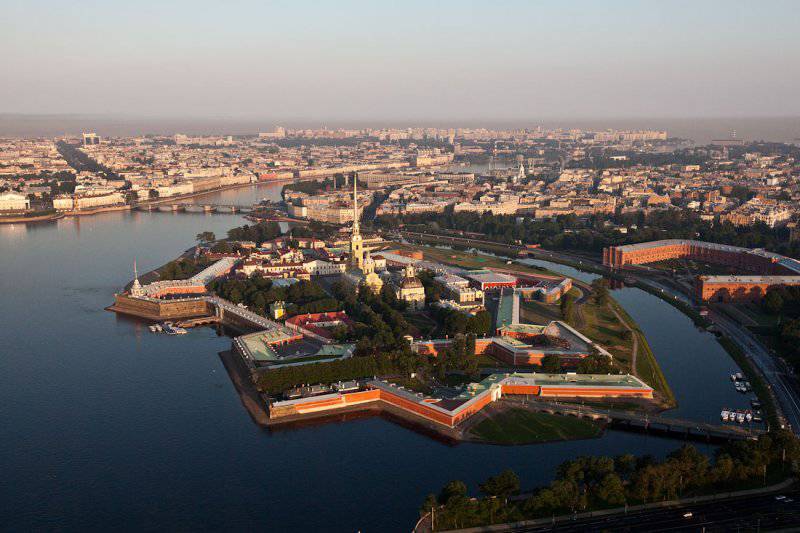
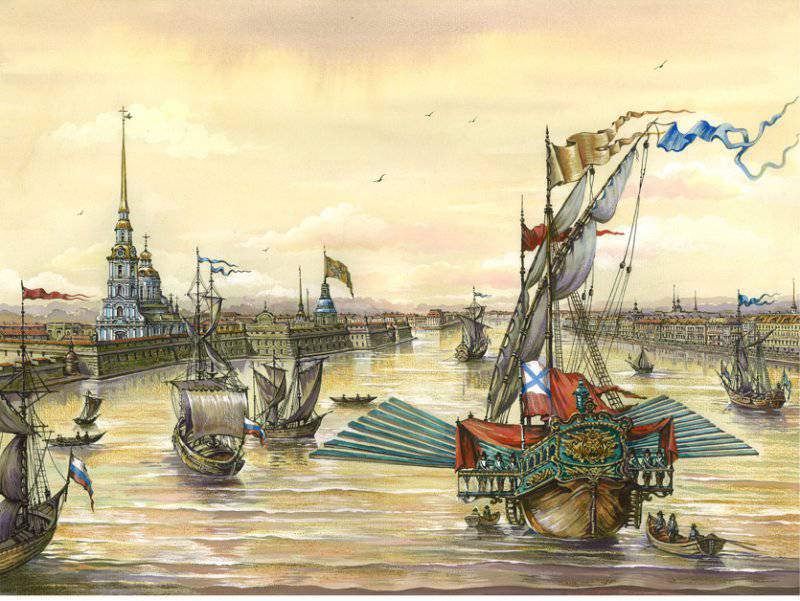
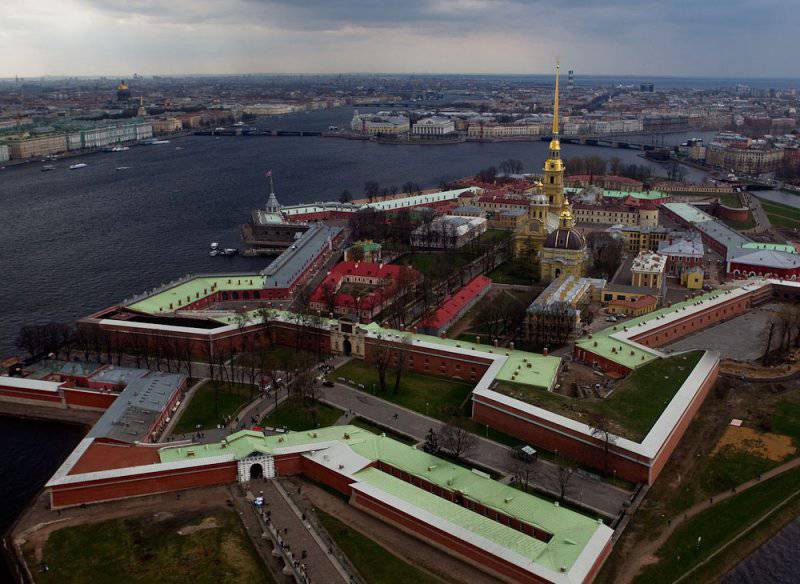
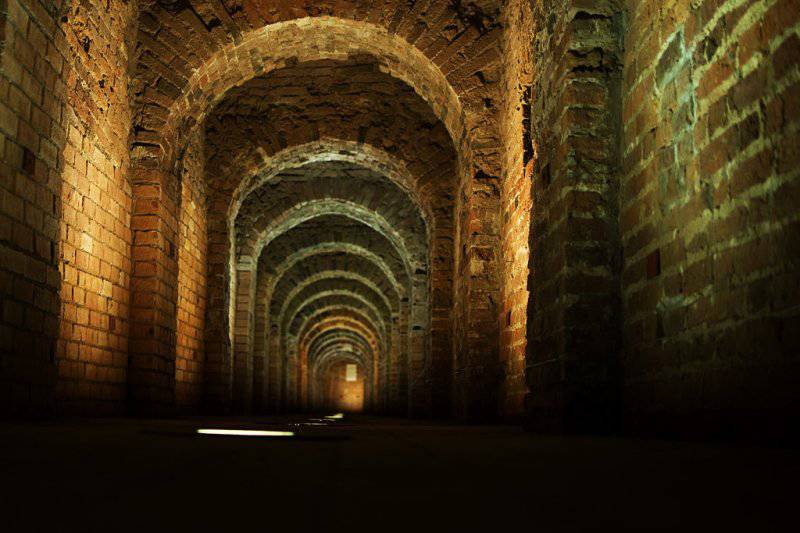
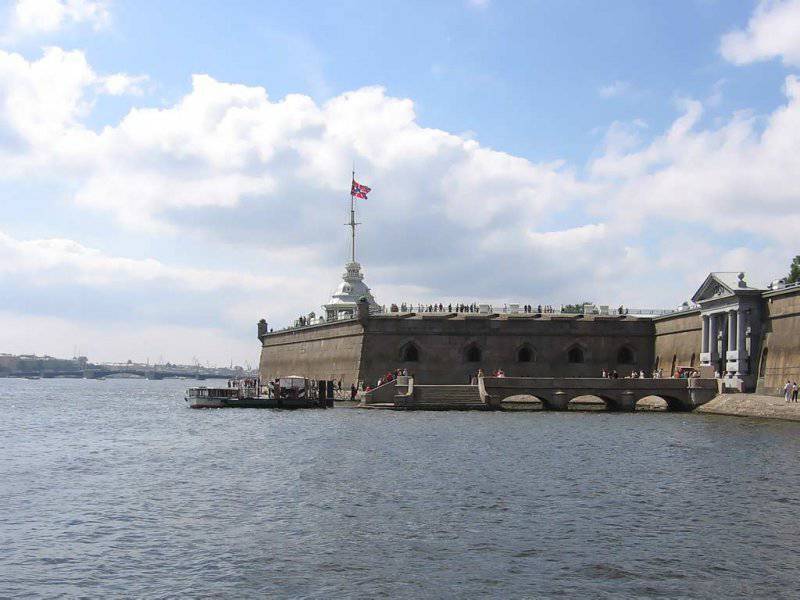
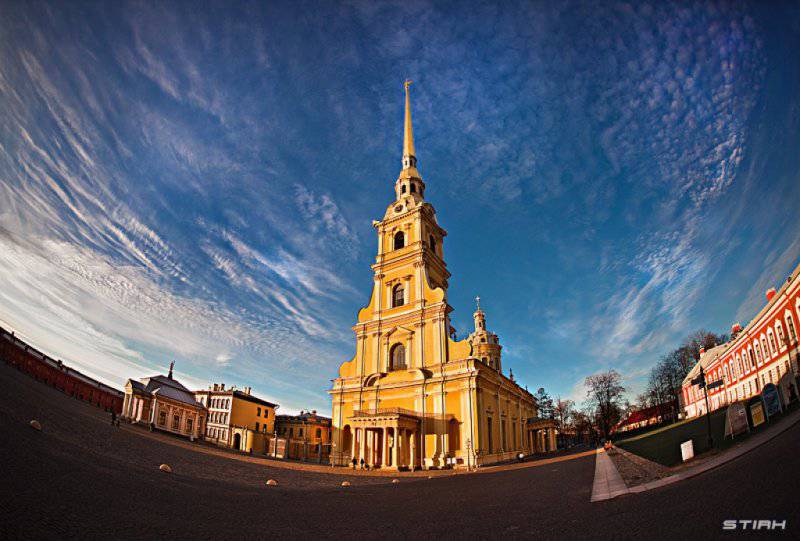
Information